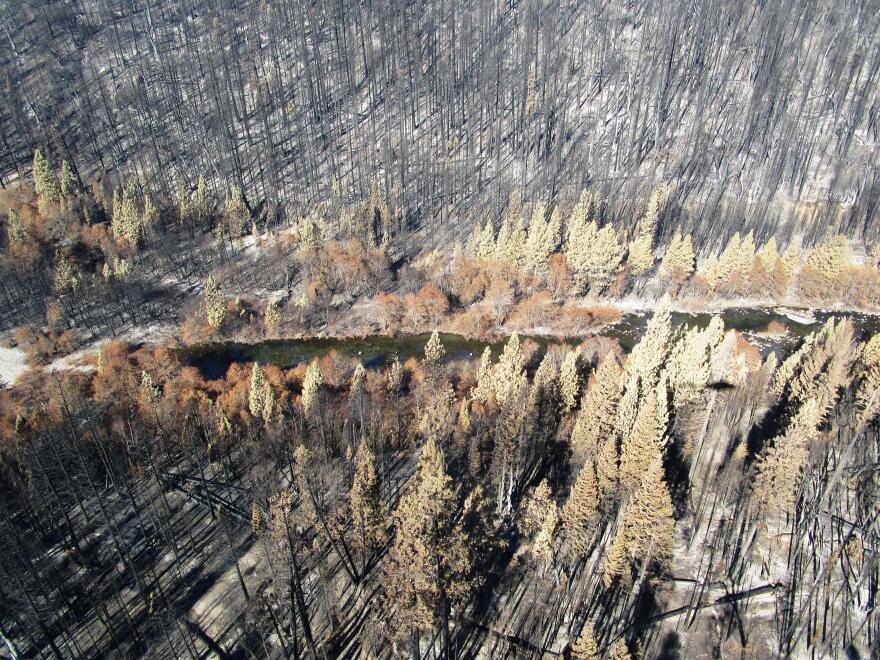An hour east of Sacramento, Calif., trucks carrying burned timber from the Eldorado National Forest roar down the canyon as chain saws buzz in the distance.
But U.S. Forest Service ecologist Becky Estes says besides humans, not much else in this forest seems alive.
"We're standing in an area that ... is going to be probably 100 percent mortality of the trees," Estes says.
Rainstorms continue to pound drought-stricken California, where dangerous mudslides have caused serious damage in areas burned by wildfires. This year, the state had one of its worst wildfire seasons on record.
Starting in September, the King Fire burned nearly 100,000 acres in the Eldorado. In this steep river canyon, 50,000 acres burned in one day. Now the pine trees are black and lifeless, and not one pine needle remains on the branches.
"The amount of needles that were consumed off of these trees, in the time frame that it happened in, was much more of a severe case than the Rim Fire," Estes says. The Rim Fire, which burned into Yosemite National Park last year, was the largest wildfire ever in the Sierra Nevada.
The damage isn't limited to the trees. Eric Nicita, a scientist with the Forest Service, is looking for earth that wasn't scorched. It's difficult. A quarter of the soil in the fire-damaged area suffered what scientists call a high-severity burn.
"What I really want to do is get some unburned soil, what it's supposed to look like, but on the way here I couldn't find it," Nicita says. "What we do is we kind of scrape away the dirt and see what's going on."

Nicita digs 2 to 3 inches into the black dirt before he can find any living plant roots. He says he's never seen a fire burn so much soil so severely.
"What influences the burn severity is the amount of organic material that's on the ground," he says. "If it's a nice, clean forest with little buildup, those generally don't burn that hot."
But fire hadn't burned the vegetation on this ground for 120 years. That built-up fuel, combined with the steep slopes of the canyon, the constant wind and the drought conditions, kept the fire raging.
The damage will get worse, Nicita says. Water now beads on the charred soil and runs off.
"Even though we've had, what, 5 or 6 inches of rain, we're only getting soil wetting down to about a half an inch to an inch," he says. "We're dusty dry down below an inch."
Forest Service crews are busy with backhoes, moving rock to divert runoff flows along roads. But rain has already caused falling rocks and debris, says Barrett McMurtry, a Forest Service engineer.
"There's been equipment mobilized here around the clock keeping up with the debris flow as it comes off the hillside," McMurtry says.

The potential problems from erosion are widespread. Reservoirs and hydropower dams are within the burn area. The Forest Service had hoped that California's drought would make mudslides unlikely. But now that the rains have come, the drought has made the mudslide danger worse.
So far, mudslides in the King Fire burn area have been small, but the Forest Service says it's only a matter of time. Nicita points up to an almost vertical slope next to a heavily traveled road. Downslope from the road is the Rubicon River.
"The Rubicon is known for its fisheries," Nicita says. "It's got a great trout run and that's at high risk also, and we evaluated that, but there's not really much we can do to reduce the risk."
Copyright 2021 CapRadio News. To see more, visit CapRadio News. 9(MDEwMTk5OTQ0MDEzNDkxMDYyMDQ2MjdiMw004))




